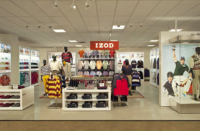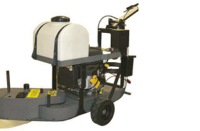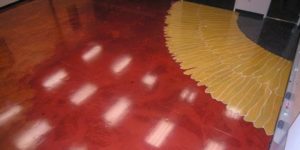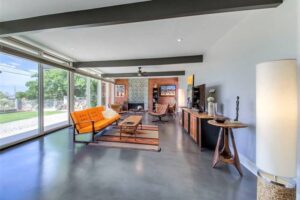
All over the country, architects who design primary and secondary schools are warming to polished concrete. Jim Ward, of Ward Scott Architecture, Tuscaloosa, Ala., is one of them. His firm’s recent project, Big Sandy Elementary School, part of the Tuscaloosa County School System, opened in 2013.
The new school is the first one the veteran firm has designed with polished floors throughout. And it showcases a wealth of decorative effects, highlighted by a “Discover Earth” theme in which each wing displays animals and plants from a different continent on its walls, floors and ceilings. Polishing contractor Jeffco Concrete Contractors, Tuscaloosa, used vinyl stencils and 20 dye shades from L. M. Scofield Co., Consolideck and AmeriPolish to lay down the artwork.
The all-polished concept isn’t a fluke. Ward says the success of Big Sandy has inspired that school district to declare that all its future schools will be polished going forward. And the project turned heads at the neighboring Tuscaloosa City Schools district, which has commissioned Ward Scott to design a new all-polished school for them as well.
Concrete Decor spoke with lead architect Jim Ward on his path toward polished concrete, what he likes about the medium, and some of the growing pains his teams have experienced embracing it
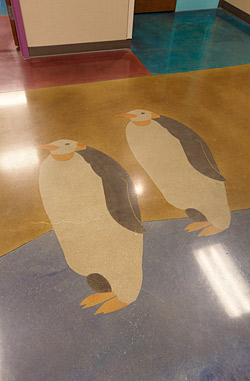
When you’re designing a school, how do you decide what kind of polished concrete to put in?
Decorative is what I was interested in, more than just solid colors of concrete floor. I wanted there to be some patterns, some decoration in the floor, because that’s traditionally what we’ve been doing, albeit with vinyl tile. We’ve had a lot of success creating some very interesting floor patterns with vinyl tile working with my interior designer — tiles cut with a water jet so patterns come in a box ready to be put down. We wanted to try to accomplish that as much as we could with polished concrete.
I think more and more, we are realizing the real cost benefits of polished concrete to the school system down the road, and we think that’s where we need to go. So we’re trying our best to embrace that product and yet still provide some decoration that we’re used to doing in schools.
What first led you to consider polished concrete — the decorative aspect or the cost benefits?
I think it was the cost benefits to start with. We started hearing about it and were interested. Three or four years ago, we traveled around central Alabama with a previous school superintendent looking at polished concrete projects that had been done. Some we liked a lot, some we didn’t like so much. Some were done at a high-quality level, some not so well. But we saw the benefits of it, and we liked it, and we wanted to try it some more to see if it works for us.
When you say you saw projects that were low-quality, what do you mean by low quality?
It appeared that the polishing was not wall-to-wall, and that there were some areas close to the wall that maybe did not receive the right kind of equipment in order to match the field.
You started with the cost benefits. How did you learn about the decorative opportunities?
That was part of what we went to see when we toured the schools. We and the superintendent were always fond of the decorative aspects of flooring in schools. And in fact, the school I mentioned that had kind of a low-quality installation really had kind of a low-quality color layout too. The whole school was really pretty dull. And we didn’t want it like that! We wanted to do more.
What I’m hearing and learning, and I may be on the back end of the learning curve, is that we have more opportunities to introduce color in the last couple of years than we did previously.
Going forward I’m going to consider what else we can do with concrete to brighten up those colors a little more. But we’ve had great success with patterns at Big Sandy, and it’s interesting it turned out as well as it did.
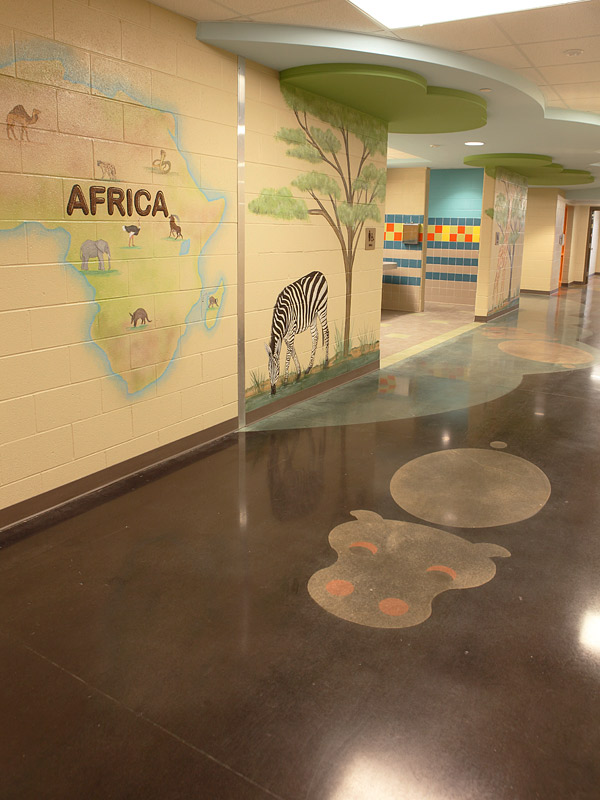
When you were looking around, do you remember who first told you, ‘Look, it can look better than this. There are some color options that you can look into?’
I’ve known Jeff McCool (president of Jeffco) for 25 years and we’ve worked on many different decorative concrete projects other than polished concrete, and he really worked hard to bring polished concrete to our attention.
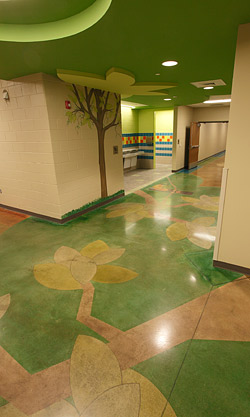 I’ve always been around his treatment of concrete — staining and Bomanite and those things. Stained concrete had to have a sealer put on it, which then became something that had to be resealed down the road. It never seemed to take off. It was more of a hassle to take care of than what the school maintenance personnel were used to dealing with. So we were never sold that it was the best solution.
I’ve always been around his treatment of concrete — staining and Bomanite and those things. Stained concrete had to have a sealer put on it, which then became something that had to be resealed down the road. It never seemed to take off. It was more of a hassle to take care of than what the school maintenance personnel were used to dealing with. So we were never sold that it was the best solution.
You did a polishing test in a cafeteria at another school before you did Big Sandy.
We decided to polish the cafeteria at Duncanville Middle School (a Tuscaloosa County school) four or five years ago, probably before we decided to visit other schools in the state. We have some large swaths of dyed color in there. One corner of the room would be one color and another corner of the room would be another color, and there would be a big circle in the middle. Not a whole lot of an attempt at intricate patterns.
And we’ve heard only good things from the principal since then, so that’s encouraged us to try to use that some more. We’ve used it in places like activity buildings, indoor play areas, cafeterias. But Big Sandy is the first school where we just used it throughout.
Now we’re up to the Big Sandy project. Whose idea was the continent motif?
I think the motif of all the patterns came from the interior designer. It’s a world theme, and different parts of the school cover different continents. The designer, Deborah Roy, came up with images of these continents and created templates and plans that showed the contractor what to do and where to put it. That was coupled with paintings on the walls that worked with that motif. It’s not just the floors, but also the walls and the floors.
Throughout the time I was learning about polished concrete, Deborah was learning about it at the same time. We liked the idea of the product, wanted bright colors, and I think we’re beginning to see that we can get there with it. At first I didn’t think we could.
The maintenance aspect has made us look more closely at it, and I think that we’re now seeing that we can get where we want to be from a decorative point of view.
You mentioned cost benefits, maintenance and growing decorative capabilities — what are the other benefits of polished concrete in the school that you can see?
It’s permanent. You’re not going to be replacing that floor.
Is polished concrete cheaper than tile?
No, I think the upfront cost is more but it pays for itself in a short period of time.
Now you’re moving on to a newer project that is also going to involve polished concrete with decorative aspects. Is that true?
Yes, that’s true. In a different school system, we have a project that will be built next year. It’s a new K-8 school in the Tuscaloosa City system. It’s a replacement for an elementary school we did that was destroyed by the tornado in 2011. It will be a performing arts school too, and we’re going to utilize the polished concrete again through the building. I think everybody’s really kind of settled on that being the best permanent, durable floor for schools going forward.
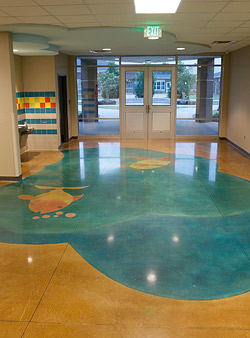 Is there anything you’ve learned from the Big Sandy job that you plan to incorporate into plans for the new school that will improve the job?
Is there anything you’ve learned from the Big Sandy job that you plan to incorporate into plans for the new school that will improve the job?
I think we’re paying more attention to what we need to do to the concrete for controlling cracking. We’re putting in an admixture (Eclipse 4500 shrinkage-reducing admixture, from W.R. Grace and Co.) to help reduce the cracking during the initial 28-day period as the concrete cures, and we’re hoping that’s going to make a difference. We had some — concrete’s going to crack, no matter what. We try to control it and it’s still going to crack in some places that you wish it hadn’t. We just want to reduce the number of those if we can.
Have you found that there are spaces in schools where it’s better to not have polished concrete?
Certainly the media center needs to be a quieter place, and so we’re putting carpet in the media center for that reason. In an elementary school, kids spend a lot of time on the floor, and a concrete floor may not be as comfortable, but elementary school teachers always use, and we expect they will use going forward, throw rugs in areas where the kids are going to be on their knees on the floor.
We are putting a real gymnasium in (the K-8 school), so we are putting a little bit of a more resilient floor in there just to provide a little bit more protection for kids as they fall. It’s going to be a soft rubber material, only about 3/8-inch thick, that sits on top of the concrete. Just a finished concrete floor in a gymnasium can potentially cause more injuries.
In the cafeteria there’s going to be a lot of food spills. Do you do any special treatments in cafeterias to guard against food stains?
I haven’t, and I haven’t had any problems with that in the cafeteria, eating and dining area. We do have problems with that in the kitchen and I put in porcelain tile to provide a nonporous surface. But in the dining area we have not done anything extra and have not had any problems.
Going back a little bit, when you talked about how the interior designer had designs on the walls and floor, it sounds like from an architectural standpoint there was an attempt to create a complete environment in which concrete plays a part.
Yes, and really kind of a permanent motif. Which is done in talking with the school system and particularly the school principal about goals for the school. It needs to be something as basic as world geography, things that never change, in order to do something as permanent as putting it in the concrete floor. That which is painted on the wall can be painted over in time, but to start out with, we give them a total design that encompasses everything.
From a conceptual standpoint, what advantages are there for students and teachers to have that kind of environment?
I think it enriches the environment and piques the interest in the educational part of what they do. That’s our job, is to create a good educational environment for children, and I think those kinds of decorations create interest and questions and discussions that augment the whole educational process.
The triangular relationship between your firm, Deborah Roy, the people placing the concrete — how does that work?
The interior designer is working for me, so we’re a team, all one design team, and we work together as we have on many other projects. On this one we got together and talked about what we were going to do. I listened to her ideas, we modified those and moved forward.
But particularly as we learning more and more about polished concrete, we did that in concert with Jeff McCool, gaining from his experience as well, as to what our options are and how we handle what we’d like to do. There was a discussion through all of this about how polished concrete works and how we can integrate designs into it, particularly on this project. Because this is the first time we’ve done it in polished concrete as opposed to jet-cut vinyl tile.
We’re getting closer and closer to accomplishing what we have in the past with vinyl tile. We learned that from Jeff. He did some samples for us, and of course, he ultimately won the bid for us, and we eventually worked together and made it a success.
You were working with Jeff as a consultant before he won the bid, then.
Yes, and the fact is he still had to be low bidder on the project. It’s still up to him to get the project. It’s not like we were using proprietary materials that gave him a benefit in that regard. I know there are other contractors who can do exactly what we specify.
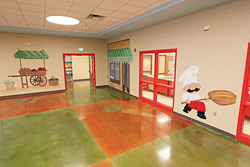 How did that relationship start? Did you turn to him and say, “We’re thinking about doing this throughout the whole school, what are your thoughts?”
How did that relationship start? Did you turn to him and say, “We’re thinking about doing this throughout the whole school, what are your thoughts?”
Yes, we did talk to him about that. And of course he’s got a product that he wants to see put in schools. He’s walked in the door several times and talked to us about it and brought us pictures. When we toured other schools, he went along with us. Some of them he did, some he didn’t do, but he looked at them and commented on them.
The fact that he’s a local contractor and is someone we’ve known for a long, long time makes it easier for us to talk to him about it as a resource. He’s really kind of pushed the product and we’ve listened and we’ve resisted and we’ve learned. He’s been a big factor in us getting to know the product.
The Tuscaloosa City school is in a different school district from Big Sandy, which is in the Tuscaloosa County district. Was their interest piqued by the Big Sandy project? Did they come to you?
We brought it up to them but they’re seeing it in more schools around the state just like we are. It’s not new news. Their knowledge of the system to start with and our encouragement and enthusiasm about it made it an easy sell. Although it’s a slightly higher cost to start with in this area, the final long-term cost makes it an easy decision.
And the Tuscalooosa County school district is now committed to doing polished concrete in all of its future schools?
Yes, moving forward that’s pretty much what we’re going to do, because everybody like the fact that you’re not having to strip and wax all the time. I think that’s a huge deal.
What we’re going to do is try our best to push the limits of what we can do with polished concrete from a decorative point of view and learn how we can do it better. I already mentioned reducing cracking. I’d like to look into ways to brighten the colors some and I know there are ways to do that. We’re just learning as we move forward.
When you wrote the Big Sandy spec, what polishing-related things did you address?
We really did not change our spec much. That’s part of what we’re learning from. As we see what’s happening, we’re trying to learn about what we can do to improve it. We’re still learning.
We’re doing a better job with this spec this time around, including the admixture we just discussed.
What other things are you including in the new spec?
We talked about and have decided not to include, from a cost point of view, a reinforcing mesh. We thought the cost had come down to the point where we could consider it. And we’re talking about not just fiberglass, but something that’s more of a high-end product, that’s more metallic. The cost is something that we cannot deal with yet.
And then I’m going to take a look at color improvement in the concrete as well.
